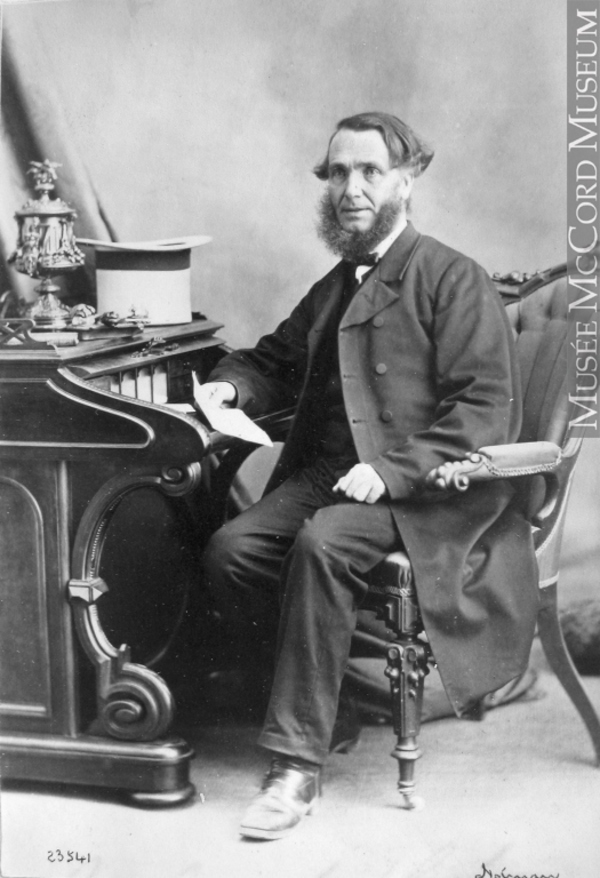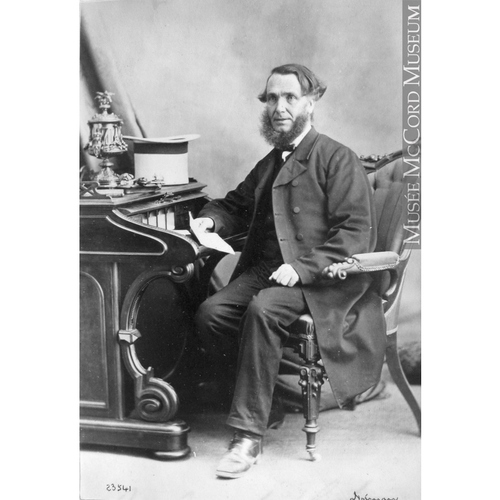
Source: Link
MIDDLETON, ROBERT, journalist; b. 1810 at Berwick-upon-Tweed, England; m. Margaret Jameson (d. 23 Dec. 1854), and they had at least two sons and four daughters; m. again 20 Feb. 1856 Elizabeth Smith in Melbourne, Lower Canada, and they had no children; d. 26 Aug. 1874 in Trois-Rivières, Que., and was buried three days later in Mount Hermon Cemetery in Saint-Colomb-de-Sillery (Quebec City).
After apprenticeship to a printer in Scotland, Robert Middleton married and emigrated. He arrived in Quebec City in 1832 during the Asiatic cholera outbreak, and at the height of a political crisis involving John Neilson*, owner and editor of the Quebec Gazette, the oldest and leading newspaper in the Canadas. Neilson, long the proponent in the assembly of French Canadian rights, had just broken with his former ally Louis-Joseph Papineau, refusing to vote in censure of the governor general, Lord Aylmer [Whitworth-Aylmer* ]. To clarify his position, Neilson in April 1832 began publishing a separate French version of his paper three times a week, at the same time continuing an English edition three times a week. The young Middleton took charge of the printing press and book shop while Neilson battled in parliament and in editorials. After Neilson lost his seat in the 1834 election, his sons Samuel* and William successively took over ownership of the paper. Though Neilson still wrote articles, Middleton is listed until 1847 in Quebec City and Canada directories as “Editor.” The paper published important accounts of constitutionalism and the insurrections, and of Neilson’s opposition to the union of the two Canadas. From 1842 to 1847 the Gazette published only in English.
Middleton, Neilson’s printer, writer, and bookseller, also became a lay preacher at Centenary Methodist Chapel in 1838, and by 1844 was superintendent of the Sunday schools in the Saint-Louis suburbs and corresponding secretary of the Quebec Auxiliary Bible Society.
In May 1847 there was a political crisis over the question of local responsible government in the colonies. Neilson battled against Francis Hincks* and Robert Baldwin*. On 18 May 1847 Middleton left Neilson’s Gazette and with Charles Saint-Michel set up a rival publication, the Morning Chronicle, on the Côte de la Montagne, taking a stand for Canadian self-government and supporting the views of Lord Elgin [Bruce*] while attacking those of his predecessor, Charles Theophilus Metcalfe*. The new paper also announced its intention to emphasize commercial and shipping news, and to include more literary reviews than its rivals. Neilson, “Bookseller and Stationer,” continued to publish the Gazette, also at premises on Côte de la Montagne, writing fiery editorials till the eve of his death on 1 Feb. 1848. Neilson’s third son, John, inherited the publication and hired Ronald Macdonald* as editor for the next three months. Then he invited Robert Middleton to rejoin the Gazette as a partner. Within a few months the younger Neilson retired, leaving Middleton as editor, and from May 1849 as proprietor. The stationery and bookselling shop had been suspended on the death of John Neilson, but was revived by Middleton.
Politically, Middleton swung the Gazette in the spring of 1849 to support of Baldwin and Louis-Hippolyte La Fontaine*, Hincks and Augustin-Norbert Morin*. L’Avenir, founded in 1847 by Jean-Baptiste-Éric Dorion*, emerged as a rallying point for the late John Neilson’s followers. During the Hincks-Morin administration, the Gazette, still liberal, became the official government organ. Middleton took John T. Dawson into partnership in the paper and shop in 1856.
Middleton, who had written strong pleas for Quebec in the “seat of government question,” found his paper diminishing in power when the capital shifted from city to city. In 1857 the Gazette dropped from daily to tri-weekly publication. Now politically independent and moderate, the Gazette gave more and more space to literary reviews, the latest news from overseas and from the United States, announcements of ship arrivals, and good-humoured debate with its rival, the Quebec Mercury. In 1864, the centenary of the founding of the Gazette, Middleton was editorializing mildly about confederation, and more vehemently on civic questions such as the plight of victims of fire, the nature of Irish celebrations on St Patrick’s Day, and the good work being done by evangelical harbour missionaries. When the government moved permanently to Ottawa in 1866, the Gazette’s value as first-hand observer of day-to-day activities in the house ceased. During Middleton’s last years, the now Conservative Gazette focused on business and shipping news. After his death the paper merged with the Morning Chronicle he had helped to found, and the successor was named the Quebec Chronicle and Quebec Gazette (1875).
Middleton’s editorials, lively and direct, brought him wide respect as an accurate and impartial reporter. Like his predecessor, Neilson, whom he praised for being “always on the side of truth, honesty and virtue,” he had an attractive ironic touch and a gusto in political reporting.
Morning Chronicle (Quebec), 1847–49. Quebec Gazette, 1833–74. Beaulieu et Hamelin, Journaux du Québec. McLaughlin’s Quebec directory . . . for 1855–1856, comp. Samuel McLaughlin (Quebec, 1855); 1857–1858 (Quebec, 1857). Morgan, Bibliotheca Canadensis. The Quebec directory, and city and commercial register, 1847–1848, comp. Alfred Hawkins (Montreal, 1847). A history of Canadian journalism . . . (2v., Toronto, 1908–59), I. Canada, an encyclopædia, V, 221, 226.
Careless, Union of the Canadas. Christie, History of Lower Canada, III, IV. Dent, Last forty years. Elzéar Gérin, La Gazette de Québec (Québec, 1864). W. H. Kesterton, A history of journalism in Canada (Carleton Library series, 36, Toronto, 1967). S. M. E. Read, “An account of English journalism in Canada from the middle of the eighteenth century to the beginning of the twentieth, with special emphasis being given to the periods prior to confederation,” unpublished ma thesis, McGill University, 1925. Shortt, Sydenham. Waite, Life and times of confederation.
Revisions based on:
Library and Arch. Can. (Ottawa), R233-29-7, vols.158–259, Can. Est, dist. Québec (county) (38), subdist. Quebec (city) (558): 184; vols.463–607, Can. Est, dist. Québec, subdist. Québec (St Jean): 26; R233-34-0, Que., dist. Quebec Centre (146), subdist. St Jean Ward (B): 43. Bibliothèque et Arch. Nationales du Québec, “Registre d’inhumation du Mount Hermon Cemetery, 1848–1904”: banq.qc.ca (consulted 27 Sept. 2018); Centre d’arch. de Sherbrooke, Québec, CE501-S83, 20 févr. 1856; Centre d’arch. de Québec, CE301-S68, 26 déc. 1854, 29 août 1874. Le Canadien (Québec), 28 août 1874.
Cite This Article
Elizabeth Waterston, “MIDDLETON, ROBERT,” in Dictionary of Canadian Biography, vol. 10, University of Toronto/Université Laval, 2003–, accessed April 25, 2025, https://www.biographi.ca/en/bio/middleton_robert_10E.html.
The citation above shows the format for footnotes and endnotes according to the Chicago manual of style (16th edition). Information to be used in other citation formats:
| Permalink: | https://www.biographi.ca/en/bio/middleton_robert_10E.html |
| Author of Article: | Elizabeth Waterston |
| Title of Article: | MIDDLETON, ROBERT |
| Publication Name: | Dictionary of Canadian Biography, vol. 10 |
| Publisher: | University of Toronto/Université Laval |
| Year of publication: | 1972 |
| Year of revision: | 2019 |
| Access Date: | April 25, 2025 |



